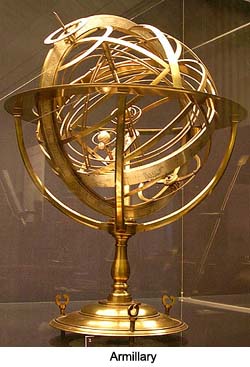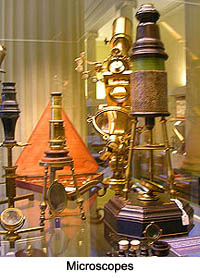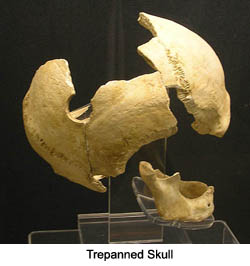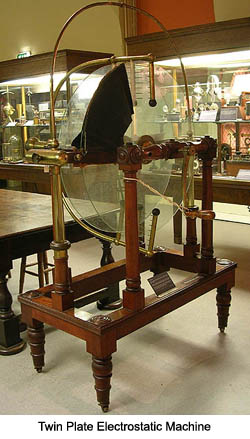Oxford's Museum of the History of Science
by Sean McLachlan
 Visitors to Oxford are sure to stroll down Broad
Street, at the heart of the town's historic center. Attracted by
the famous curved facade of the Sheldonian Theatre, many miss the
modest white building tucked next to it. Here is one of the
hidden gems of Oxford, an unusual collection of artifacts called
the Museum of the History of Science. Visitors to Oxford are sure to stroll down Broad
Street, at the heart of the town's historic center. Attracted by
the famous curved facade of the Sheldonian Theatre, many miss the
modest white building tucked next to it. Here is one of the
hidden gems of Oxford, an unusual collection of artifacts called
the Museum of the History of Science.
The building was erected in 1683 to house the Ashmolean Museum,
one of the first museums open to the general public. Eventually
the Ashmolean collection became too large and moved to its
present quarters on Beaumont Street. In 1924, Oxford University
received a large donation of scientific instruments and decided
to use the building to display the collection and other artifacts
showing the history of scientific endeavor.
The front
hall is mostly dedicated to the study of the heavens, with a vast
array of early astrolabes, sundials and armillary spheres.
Astrolabes were disc-shaped sighting devices used to measure the
position of celestial bodies and were essential for early
navigators to determine where they were on the open sea.
Armillary spheres were made up of concentric rings that showed
the relative motions of the sun, planets, and stars. These were
not only precise scientific instruments, but works of art as
well. Their polished brass surfaces and elaborate engravings lend
them aesthetic as well as scientific interest.
A pair of armillary spheres dating to about 1700 show competing
models of the universe. One has the Earth stationary at the
center in the Ptolemaic system of the ancient Greeks. The other
shows the later Copernican system, in which the sun is at the
center and the Earth and the other planets revolve around it.
 Nearby is a
fine collection of microscopes used in the 18th and 19th
centuries by the Royal Microscopical Society. Also check out the
early German sundials with fine ivory carvings, combining
timekeeping with folk art. Nearby is a
fine collection of microscopes used in the 18th and 19th
centuries by the Royal Microscopical Society. Also check out the
early German sundials with fine ivory carvings, combining
timekeeping with folk art.
There are also displays showing how time was measured in
different centuries. One gallery is entirely dedicated to clocks,
and in various spots around the museum sit the ponderous, rusting
remains of old clocks taken from clock towers around England.
Their heavy-duty gears and pulleys look crude, but these simple
instruments kept accurate time for decades or even centuries.
The upper floor has more astronomical instruments, as well as a
display of early calculators. One unwieldy device was the
Arithmometer Calculating Machine, patented in France in 1820. It
was capable of simple calculations and became extremely popular
with engineers and businessmen. Older visitors will remember the
slide rule, and be surprised to find out that the example made in
London in 1688 wasn't much different than the ones they remember
from their youth.
Nearby, a small globe is surrounded by a sphere of glass with a
clock on front. As the clock runs, the glass turns. Marks on the
glass show the time and date for various spots on the Earth. It
was made in Vienna in the mid-nineteenth century. A larger globe
from All Soul's College shows the world as the English knew it in
1793. It's surprising to see how few of today's countries existed
only 200 years ago.
 The
basement is a veritable alchemist's laboratory of arcane
equipment. In fact, you'll find some actual tools used by ancient
alchemists here. Wandering through the displays you'll learn the
difference between such arcane devices as an alembic and a
retort. You'll also see what early doctors were up to with the
example of a trepanned skull. Trepanning was an operation in
which a piece of the skull was removed in order to release
pressure on the brain, in order to relieve head trauma, insanity,
or to bring on religious visions. While this sounds like
something too dangerous to try in the days before modern medicine
(indeed, most surgeons didn't even wash their hands until the
19th century) this example proves the operation could be
successful. The hole shows signs of healing, indicating the
patient survived for several months. A more modern but less
reliable remedy was Dr. James' Fever Powder, c.1770, invented by
Robert James, M.D., a member of St. Johns College, Oxford. At 2
shillings, sixpence a packet, it wasn't cheap, and it gained its
greatest fame when it was said to have killed the famous poet
Oliver Goldsmith. The
basement is a veritable alchemist's laboratory of arcane
equipment. In fact, you'll find some actual tools used by ancient
alchemists here. Wandering through the displays you'll learn the
difference between such arcane devices as an alembic and a
retort. You'll also see what early doctors were up to with the
example of a trepanned skull. Trepanning was an operation in
which a piece of the skull was removed in order to release
pressure on the brain, in order to relieve head trauma, insanity,
or to bring on religious visions. While this sounds like
something too dangerous to try in the days before modern medicine
(indeed, most surgeons didn't even wash their hands until the
19th century) this example proves the operation could be
successful. The hole shows signs of healing, indicating the
patient survived for several months. A more modern but less
reliable remedy was Dr. James' Fever Powder, c.1770, invented by
Robert James, M.D., a member of St. Johns College, Oxford. At 2
shillings, sixpence a packet, it wasn't cheap, and it gained its
greatest fame when it was said to have killed the famous poet
Oliver Goldsmith.
 A slightly less
frightening artifact is the Twin Plate Electrostatic Machine, c.
1840. Two large plate-glass discs are spun with a crank, rubbing
against leather and silk taffeta cushions. The action of the
glass against the cloth created a huge electrostatic charge,
similar to rubbing your feet against a carpet on a dry day. While
the machine is fully insulated and is perfectly safe, it created
huge sparks. Such showy devices were popular in the 18th and 19th
centuries for traveling science exhibitions, which combined
technology and theater to give an educational lecture. A slightly less
frightening artifact is the Twin Plate Electrostatic Machine, c.
1840. Two large plate-glass discs are spun with a crank, rubbing
against leather and silk taffeta cushions. The action of the
glass against the cloth created a huge electrostatic charge,
similar to rubbing your feet against a carpet on a dry day. While
the machine is fully insulated and is perfectly safe, it created
huge sparks. Such showy devices were popular in the 18th and 19th
centuries for traveling science exhibitions, which combined
technology and theater to give an educational lecture.
Perhaps the most important artifact on this floor is also the
most mundane. A simple blackboard hangs high upon one wall. This
blackboard was the one used by Albert Einstein in his famous
Oxford lectures on relativity. During the 1920s, astronomer Edwin
Hubble had discovered that other galaxies were moving away from
our own. In the lecture Einstein gave on May 16, 1931, he
outlined a relatively simple theory to explain the apparent
expansion of the universe. The equations he set down for his
fellow physicists are still preserved in his own handwriting.
The Museum of the History of Science is located on Broad Street,
next to the Sheldonian Theatre and across from the famous
Blackwell's Bookshop. Admission is free and hours are from 12 to
4 p.m., Tuesday to Saturday, and 2 to 5 p.m. Sunday. They are on
the web at http://www.mhs.ox.ac.uk/
Related Articles:
- The Ashmolean Museum: Oxford's Window on the Ancient World, by Sean McLachlan
- https://www.timetravel-britain.com/articles/museums/ashmolean.shtml
- Oxford: A Melange of Magic, Myth and Martyrs, by Sue Kendrick
- https://www.timetravel-britain.com/articles/towns/oxford.shtml
More Information:
We regret that we no longer have the resources to maintain up-to-date links and/or hours and pricing details for the various sites and attractions listed on this website. For more information about the location(s) listed above, please use your favorite search engine or visit Wikipedia.
Article © 2006 Sean McLachlan
Photos © Almudena Alonso-Herrero.
|
